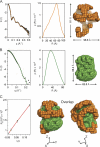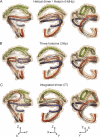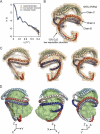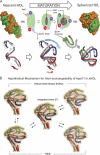The low resolution structure of ApoA1 in spherical high density lipoprotein revealed by small angle neutron scattering
- PMID: 21292766
- PMCID: PMC3069452
- DOI: 10.1074/jbc.M110.209130
The low resolution structure of ApoA1 in spherical high density lipoprotein revealed by small angle neutron scattering
Abstract
Spherical high density lipoprotein (sHDL), a key player in reverse cholesterol transport and the most abundant form of HDL, is associated with cardiovascular diseases. Small angle neutron scattering with contrast variation was used to determine the solution structure of protein and lipid components of reconstituted sHDL. Apolipoprotein A1, the major protein of sHDL, forms a hollow structure that cradles a central compact lipid core. Three apoA1 chains are arranged within the low resolution structure of the protein component as one of three possible global architectures: (i) a helical dimer with a hairpin (HdHp), (ii) three hairpins (3Hp), or (iii) an integrated trimer (iT) in which the three apoA1 monomers mutually associate over a portion of the sHDL surface. Cross-linking and mass spectrometry analyses help to discriminate among the three molecular models and are most consistent with the HdHp overall architecture of apoA1 within sHDL.
Figures




Similar articles
-
Protein Backbone and Average Particle Dynamics in Reconstituted Discoidal and Spherical HDL Probed by Hydrogen Deuterium Exchange and Elastic Incoherent Neutron Scattering.Biomolecules. 2020 Jan 10;10(1):121. doi: 10.3390/biom10010121. Biomolecules. 2020. PMID: 31936876 Free PMC article.
-
Apolipoprotein A1 Forms 5/5 and 5/4 Antiparallel Dimers in Human High-density Lipoprotein.Mol Cell Proteomics. 2019 May;18(5):854-864. doi: 10.1074/mcp.RA118.000878. Epub 2019 Jan 18. Mol Cell Proteomics. 2019. PMID: 30659061 Free PMC article.
-
The low-resolution structure of nHDL reconstituted with DMPC with and without cholesterol reveals a mechanism for particle expansion.J Lipid Res. 2013 Apr;54(4):966-83. doi: 10.1194/jlr.M032763. Epub 2013 Jan 23. J Lipid Res. 2013. PMID: 23349207 Free PMC article.
-
Structure and function of apolipoprotein A-I and high-density lipoprotein.Curr Opin Lipidol. 2000 Apr;11(2):105-15. doi: 10.1097/00041433-200004000-00002. Curr Opin Lipidol. 2000. PMID: 10787171 Review.
-
ApoA1 and ApoA1-specific self-antibodies in cardiovascular disease.Lab Invest. 2016 Jul;96(7):708-18. doi: 10.1038/labinvest.2016.56. Epub 2016 May 16. Lab Invest. 2016. PMID: 27183204 Review.
Cited by
-
Comparison of apoA-I helical structure and stability in discoidal and spherical HDL particles by HX and mass spectrometry.J Lipid Res. 2013 Jun;54(6):1589-1597. doi: 10.1194/jlr.M034785. Epub 2013 Apr 10. J Lipid Res. 2013. PMID: 23580759 Free PMC article.
-
Molecules that mimic apolipoprotein A-I: potential agents for treating atherosclerosis.J Med Chem. 2014 Mar 27;57(6):2169-96. doi: 10.1021/jm4005847. Epub 2013 Oct 29. J Med Chem. 2014. PMID: 24168751 Free PMC article. Review.
-
New insights into the determination of HDL structure by apolipoproteins: Thematic review series: high density lipoprotein structure, function, and metabolism.J Lipid Res. 2013 Aug;54(8):2034-2048. doi: 10.1194/jlr.R034025. Epub 2012 Dec 10. J Lipid Res. 2013. PMID: 23230082 Free PMC article. Review.
-
Myeloperoxidase, paraoxonase-1, and HDL form a functional ternary complex.J Clin Invest. 2013 Sep;123(9):3815-28. doi: 10.1172/JCI67478. Epub 2013 Aug 1. J Clin Invest. 2013. PMID: 23908111 Free PMC article.
-
Lipoproteins comprise at least 10 different classes in rats, each of which contains a unique set of proteins as the primary component.PLoS One. 2018 Feb 20;13(2):e0192955. doi: 10.1371/journal.pone.0192955. eCollection 2018. PLoS One. 2018. PMID: 29462161 Free PMC article.
References
-
- Castelli W. P., Doyle J. T., Gordon T., Hames C. G., Hjortland M. C., Hulley S. B., Kagan A., Zukel W. J. (1977) Circulation 55, 767–772 - PubMed
-
- Durrington P. N., Ishola M., Hunt L., Arrol S., Bhatnagar D. (1988) Lancet 1, 1070–1073 - PubMed
-
- Pekkanen J., Linn S., Heiss G., Suchindran C. M., Leon A., Rifkind B. M., Tyroler H. A. (1990) New Engl. J. Med. 322, 1700–1707 - PubMed
-
- Karathanasis S. K., Norum R. A., Zannis V. I., Breslow J. L. (1983) Nature 301, 718–720 - PubMed
-
- Norum R. A., Lakier J. B., Goldstein S., Angel A., Goldberg R. B., Block W. D., Noffze D. K., Dolphin P. J., Edelglass J., Bogorad D. D., Alaupovic P. (1982) New Engl. J. Med. 306, 1513–1519 - PubMed
Publication types
MeSH terms
Substances
Grants and funding
LinkOut - more resources
Full Text Sources
Miscellaneous

